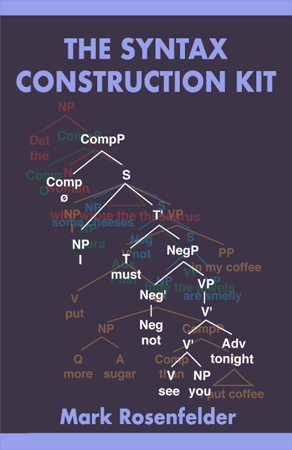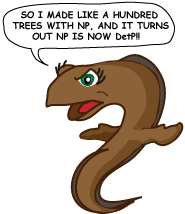
by Mark Rosenfelder
You’ve read The Language Construction Kit, dived deeper with Advanced Language Construction, and created words with The Conlanger’s Lexipedia. Is there more to learn?
Yes! How about a tour of modern syntax?
You might, in the tradition of Whitney’s magisterial Sanskrit grammar, have hundreds of pages devoted to phonology and morphology, and nothing on syntax. Or maybe a page which specifies what basic sentence order is. This book will show you much, much more you can do.
Syntax can be frustrating, because there are multiple schools that seem to fight over inessential things. I hope I can show you that this is normal for a new field, and that it actually makes syntax fun. New discoveries are being made, and you can participate— something that’s a lot harder to do in, say, quantum mechanics.
What’s in it?
- An introduction to the Chomsky Hierarchy, a classification of grammars that’s used both in linguistics and computer science, as well as a comparison to other generative techniques, such as Markov text generators.
- A tour of Chomsky’s methods— production rules and transformations— with overnight stays in the Syntactic Structures, X-bar, and Minimalist stages in his thought.
- A leisurely stroll through interesting bits of syntax: the English verbal complex, pronouns and other anaphors, relative clauses, quantifiers and more. The emphasis is on doing syntax— not just learning rules and drawing trees, but learning how syntactic arguments are made.
- An overview of alternatives to Chomsky’s approach: generative syntax, cognitive linguistics, relational grammars, word grammar, construction grammar, Jackendoff’s Simpler Syntax, and Comrie’s universals.
- A chapter on production which asks, how ‘real’ are these grammars? Do we really have syntactic categories and transformations in the brain, or in the genome?
- A chapter on how you can apply all this to your conlangs.
- The Syntactic Bestiary— an annotated list of transformations and constraints, which you can think about for conlanging, or use to evaluate syntactic theories.
All this with the light yet scholarly touch which has become the author's trademark among both humans and gnolls.
Elevator pitch
Suppose you want to make a machine that spits out English sentences all day long. There should be no (or very few) repetitions, and each one should be good English.How would you make that machine in the simplest way possible?
That is, we're not interested in a set of rules that require the Ultimate Computer from Douglas Adams’s sf. We know that “make a human being” is a possible answer, but we're looking for the minimum. We also, of course, don't want a machine that can't do it— that misses some sentences, or spits out errors. We want the dumbest machine that works.
One more stipulation: we don't insist that they be meaningful. We're not conducting a conversation with the machine. It's fine if the machine outputs John is a ten foot tall bear. That's a valid sentence— we don't care whether or not someone named John is nearby, or if he's a bear, or if he's a big or a small bear.
That machine is a generative grammar.
The rules of Chomsky's Syntactic Structures are in fact such a machine— though a partial one. And along with the book I'm creating a web tool, ggg, that allows you to define rules and let it generate sentences with the Syntactic Structures rules, or any other set. It works like a charm. But the SS rules were not, of course, a full grammar... far from it.
Now, besides the amusement value, why do we do this?
- It's part of the overall goal of describing language.
- It puts some interesting lower bounds on any machine that handles language.
- As a research program, it will uncover a huge store of facts about syntax, most of them never noticed before. Older styles of grammar were extremely minimal about syntax, because they weren't asking the right questions.
- It might help you with computer processing of language.
- It might tell you something about how the brain works.
You might well ask (and in fact you should!), well, how do you make such a machine? What do the rules look like? Well, that’s what the book is about!
Whet my appetite some more!
Some of my blog posts about syntax:- Doing syntax on math expressions
- Analysis of a weird tweet
- The latest on child language acquisition
- My syntax toys
- Markov text generators
- The language organ: pro and con
- Chomsky pro and con
FAQ!
- When is it available?
- It is totally out now!
- How much does it cost?
- The price is $14.95 print, $6.75 Kindle.

- Is Connie the Contortionist Conlanging Conger Eel in it?
- It’s very likely!
- Will this make any sense if I haven't read the LCK or ALC?
- You can certainly start here if you like, but I recommend that you read one or both first. A general understanding of linguistics is helpful, and the book complements the discussion of morphosyntax in ALC.
- Weren’t three books enough?
- It turns out, not quite! This is the book I really wanted to write for decades. I’ve loved this stuff since I took my first syntax class in college, but it’s very hard to explain how it works in anything less than a full book. So, here it is!
- Do I need to draw syntactic trees for my conlang?
- Probably not, though it’d be cool if you did. I do find that informally indicating transformations is very helpful in explaining the more complicated parts of a conlang’s syntax. But the biggest benefit of knowing syntax is twofold. One, you become aware of more things your language can do (or, if you add constraints, things it shouldn’t be able to do). Two, you become aware of interactions of rules. Both things will make your syntax section far meatier!
- Isn’t syntax hard?
- Kind of, but so is phonology, and you’ve probably mastered that! If you read the LCK (or took a linguistics course, or whatever), you went from thinking about letters to thinking about phonemes, and acquired a whole new vocabulary for understanding sounds. Modern syntax requires a new way of approaching language, and gives you a new set of terms and tools. In both cases, you end up with richer conlangs and you see things you wouldn’t even have noticed before.
Plus, did I mention that syntax is fun? It’s one of the few areas of linguistics where you can take a Land Rover right out to the frontier of knowledge, and discover new things. And of course, I’ve tried to make the process as easy as possible.
- Is this Chomskyan syntax?
- There is plenty of Chomsky, since he largely created generative grammar and has been its leading theorist for half a century. In practice, that means I’ll cover Syntactic Structures, X-bar theory, and Minimalism.
However, I don’t stick to just one school. I want people to learn to do syntax, not just learn the basics of Minimalism. So there is plenty about other syntactic theories, and about how we do syntax— a subject on which there’s more consensus than what theory to use.


